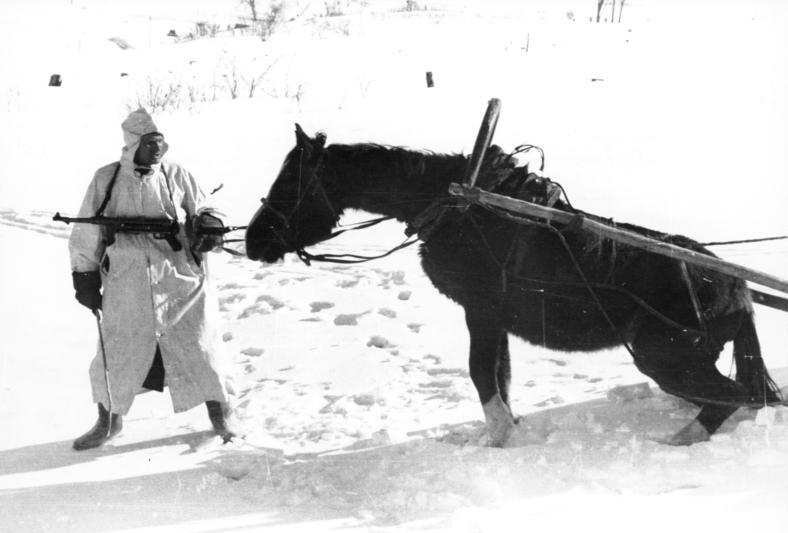Not sure how small arms and fixed encampment gun positions came into this but German artillery and infantry moved on oats for fuel-Guy I knew who was on Omaha Beach on D-Day always said they were outgunned by German weapons.
He always used the example of our .30 caliber water-cooled machine guns, which overheated constantly and took forever to reload, while the German machine guns could be reloaded in a much shorter time (sorry, I'm not an arms expert - I'm sure someone here knows more about it than I do).
The Japanese equipment may have been better, but the survivability of their planes and tanks were worse than ours.
British intelligence was excellent vs Germany and our intelligence service - and sheer guts of our Navy pilots - won the Battle of Midway, which turned the tide of the war to put us on offense.
“Horse-drawn transportation was most important for Germany, as it was relatively lacking in automotive industry[2] and oil resources. Infantry and horse-drawn artillery formed the bulk of the German Army throughout the war; only one fifth of the Army belonged to mobile panzer and mechanized divisions. Each German infantry division employed thousands of horses and thousands of men taking care of them. Despite losses of horses to enemy action, exposure and disease, Germany maintained a steady supply of work and saddle horses until 1945. Cavalry in the German Army and the Waffen-SS gradually increased in size, peaking at six cavalry divisions in February 1945.”

Horses in World War II - Wikipedia
I don’t know much about Japanese tanks but for naval operations that started the war the Zero was a far better aircraft 12-1 kill ratio is stellar-
“The Zero is considered to have been the most capable carrier-based fighter in the world when it was introduced early in World War II, combining excellent maneuverability and very long range.[2] The Imperial Japanese Navy Air Service also frequently used it as a land-based fighter.
In early combat operations, the Zero gained a reputation as a dogfighter,[3] achieving an outstanding kill ratio of 12 to 1,”
Japanese torpedo-
The Type 93 (酸素魚雷, designated for Imperial Japanese calendar year 2593) was a 610 mm (24 in)-diameter torpedo of the Imperial Japanese Navy (IJN), launched from surface ships. It is commonly referred to as the Long Lance[1] by most modern English-language naval historians, a nickname given to it after the war by Samuel Eliot Morison,[2] the chief historian of the U.S. Navy, who spent much of the war in the Pacific Theater. In Japanese references, the term Sanso gyorai (酸素魚雷, lit. "oxygen torpedo") is also used, in reference to its propulsion system.[3] It was the most advanced naval torpedo in the world at the time.
American torpedo-
“The Mark 14 was central to the torpedo scandal of the U.S. Pacific Fleet Submarine Force during World War II. Inadequate production planning led to severe shortages of the weapon. The frugal, Depression-era, peacetime testing of both the torpedo and its exploder was woefully inadequate and had not uncovered many serious design problems. Torpedoes were so expensive that the Navy was unwilling to perform tests that would destroy a torpedo. Furthermore, the design defects tended to mask each other.[36] Much of the blame commonly attached to the Mark 14 correctly belongs to the Mark 6 exploder. These defects, in the course of fully twenty months of war, were exposed, as torpedo after torpedo either missed by running directly under the target, prematurely exploded, or struck targets with textbook right angle hits (sometimes with an audible clang) yet failed to explode.[37]”
Not aware of any armor battles with US in the Pacific but I know the Japanese used in China. If Chiang Kai-shek hadn’t blown the levees on the Yellow River and killed a large number of his own citizens the Japanese would have overrun China. Their tanks were adequate for China.
Last edited:










